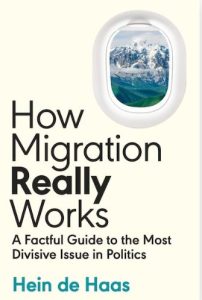New book busts myths about migration
A new book has exploded some divisive and damaging myths about migration across the globe while applying some common sense solutions to the issues that migration raises.
‘How Migration Really Works’ by sociologist Professor Hein de Hass challenges some of the common misconceptions about migration, arguing that global migration is not at an all-time high, climate change may not lead to mass migration and that migrants do not take jobs and overburden welfare systems.
 The book systematically busts myths and exposes political propaganda around migration using a balanced approach to real data.
The book systematically busts myths and exposes political propaganda around migration using a balanced approach to real data.
Prof de Haas, who is Professor of Sociology at the University of Amsterdam, argues that rather than living in an age of unprecedented mass migration, it is more like business as usual.
He says that while the number of international migrants has almost doubled between 1960 and 2000, the world population has grown at the same pace.
So, the relative rate of migration has remained stable, and less than three per cent of the world’s population is an international migrant.
Prof de Hass says the nature and direction of migration has changed.
“For the past centuries, it was mainly Europeans who emigrated and colonised foreign territories. Since WWII, Europe has evolved into the world’s most attractive migration destination,” he says.
“However, particularly since the end of the Cold War politicians have increasingly portrayed migration as a fundamental threat to security and prosperity, inflaming a panic over migration. This contributed to the incorrect idea that migration is accelerating.”
Controversially, Prof de Haas says that recent research shows that immigration restrictions are often counter-productive by interrupting circulation, discouraging return and pushing migrants into permanent settlement.
And that although politicians like to give the impression that immigration policies have become more restrictive, research shows that policies have become less restrictive for most migrant groups over the past decades.
“Tough talk on migration is therefore mainly rhetoric aimed at winning elections,” he says.
Prof de Haas says another myth is that the emigration of skilled people (‘brain drain’) causes underdevelopment in origin countries.
“The money migrants send back home as remittances dwarfs development aid, and many migrants invest in origin countries, although it is also an illusion to think that migrants can solve fundamental development problems such as corruption and inequality,” he says.
One more myth is that migrants mainly do the jobs that local populations shun or for which they lack the skills.
Prof de Haas says that, generally, migration has a positive, but comparatively small, effect on economic growth, although it is predominantly employers, the middle classes and the wealthy who benefit from migration.
And while migration is not a threat to prosperity, it is also not a solution to fundamental socio-economic problems such as ageing. The magnitude of migration is too limited, while ageing is becoming a worldwide phenomenon.
“Open and wealthy societies will inevitably experience substantial migration. The trend towards economic liberalisation in recent decades – which has increased the demand for formal and informal migrant labour – contradicts the political rhetoric in favour of less migration.
“Both the positive and negative effects of migration tend to be greatly exaggerated.
“Migration is unjustifiably seen as either a fundamental threat or a solution to fundamental societal problems. It is not migration, but rather the xenophobia fuelled by politicians and the media, that is the problem.
“The related migration panic and the recurrent scapegoating of migrants stands in the way of a nuanced debate about migration,” Prof de Haas says.
How Migration Really Works is published by Penguin Books, $19.99.












